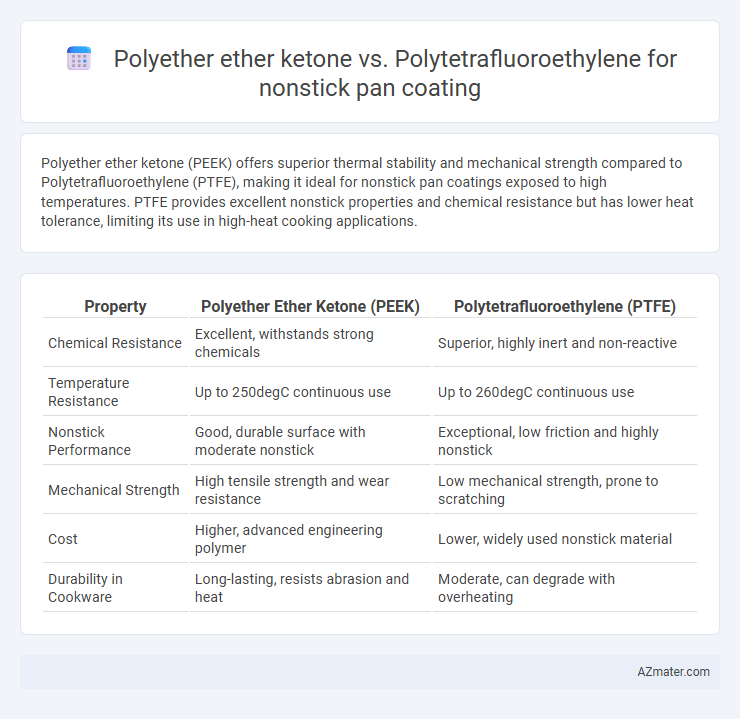Polyether ether ketone (PEEK) offers superior thermal stability and mechanical strength compared to Polytetrafluoroethylene (PTFE), making it ideal for nonstick pan coatings exposed to high temperatures. PTFE provides excellent nonstick properties and chemical resistance but has lower heat tolerance, limiting its use in high-heat cooking applications.
Table of Comparison
| Property | Polyether Ether Ketone (PEEK) | Polytetrafluoroethylene (PTFE) |
|---|---|---|
| Chemical Resistance | Excellent, withstands strong chemicals | Superior, highly inert and non-reactive |
| Temperature Resistance | Up to 250degC continuous use | Up to 260degC continuous use |
| Nonstick Performance | Good, durable surface with moderate nonstick | Exceptional, low friction and highly nonstick |
| Mechanical Strength | High tensile strength and wear resistance | Low mechanical strength, prone to scratching |
| Cost | Higher, advanced engineering polymer | Lower, widely used nonstick material |
| Durability in Cookware | Long-lasting, resists abrasion and heat | Moderate, can degrade with overheating |
Introduction to Nonstick Pan Coatings
Nonstick pan coatings enhance cooking performance by preventing food from adhering to surfaces, improving heat distribution and ease of cleaning. Polyether ether ketone (PEEK) offers exceptional thermal stability and mechanical strength, making it suitable for high-temperature cooking applications. Polytetrafluoroethylene (PTFE) is widely recognized for its superior nonstick properties and chemical inertness, though it has limitations at elevated temperatures compared to PEEK.
Overview of Polyether Ether Ketone (PEEK)
Polyether ether ketone (PEEK) is a high-performance thermoplastic known for its excellent mechanical strength, chemical resistance, and thermal stability, making it suitable for demanding applications including nonstick pan coatings. Compared to polytetrafluoroethylene (PTFE), PEEK offers superior durability and resistance to high temperatures up to 250degC without degradation or release of harmful substances. Its ability to maintain structural integrity under thermal and mechanical stress positions PEEK as a promising alternative to traditional PTFE coatings in nonstick cookware.
Overview of Polytetrafluoroethylene (PTFE)
Polytetrafluoroethylene (PTFE) is a synthetic fluoropolymer renowned for its exceptional nonstick properties and high chemical resistance, making it a popular choice for cookware coatings. Its low coefficient of friction allows food to release easily from surfaces, while its thermal stability supports cooking temperatures up to approximately 260degC (500degF). PTFE coatings offer durability and easy cleaning, although they may degrade at higher temperatures, requiring careful usage compared to alternatives like Polyether ether ketone (PEEK).
Chemical and Physical Properties Comparison
Polyether ether ketone (PEEK) offers superior chemical resistance and thermal stability up to 250degC, making it highly durable for nonstick pan coatings, whereas polytetrafluoroethylene (PTFE) excels with exceptionally low friction and a chemical inertness that withstands temperatures up to 260degC. Physically, PEEK provides enhanced mechanical strength and abrasion resistance compared to the softer, more flexible PTFE, which, while excellent for nonstick performance, can degrade under high heat or physical stress. The choice between PEEK and PTFE for nonstick coatings hinges on balancing PEEK's robustness and PTFE's unparalleled slipperiness and temperature tolerance.
Nonstick Performance: PEEK vs PTFE
Polyether ether ketone (PEEK) offers superior mechanical strength and thermal stability compared to Polytetrafluoroethylene (PTFE), making it a robust choice for nonstick pan coatings. PTFE provides exceptional nonstick performance due to its extremely low surface energy, reducing food adhesion effectively. Despite PEEK's toughness, PTFE remains the preferred material in nonstick cookware for its unparalleled slipperiness and ease of food release.
Durability and Scratch Resistance Analysis
Polyether ether ketone (PEEK) offers superior durability and scratch resistance compared to polytetrafluoroethylene (PTFE) when used as a nonstick pan coating, due to its high mechanical strength and thermal stability up to 250degC. PTFE, while providing excellent nonstick properties, tends to degrade and scratch more easily under high heat and abrasive utensils. The enhanced wear resistance of PEEK extends the lifespan of cookware, making it a preferred choice for heavy-duty cooking applications.
Safety and Food Compatibility Considerations
Polyether ether ketone (PEEK) offers superior chemical resistance, thermal stability up to 260degC, and is biocompatible, making it safe for use in nonstick pan coatings without leaching harmful substances. Polytetrafluoroethylene (PTFE), commonly known as Teflon, provides excellent nonstick properties but can release toxic fumes at temperatures above 260degC, posing health risks during overheating. Food compatibility favors PEEK due to its inert nature and durability under high-heat cooking, while PTFE requires careful temperature control to ensure safety.
Heat Resistance and Thermal Stability
Polyether ether ketone (PEEK) exhibits superior heat resistance, maintaining structural integrity at continuous use temperatures up to 250degC, while polytetrafluoroethylene (PTFE) degrades above 260degC, limiting its high-heat applications. Thermal stability of PEEK is enhanced by its semi-crystalline nature, offering excellent chemical and thermal resistance, whereas PTFE, although chemically inert, experiences thermal decomposition releasing toxic fumes beyond 350degC. For nonstick pan coatings, PEEK's higher thermal endurance and stability provide a more durable option under intense cooking conditions compared to PTFE.
Environmental Impact and Sustainability
Polyether ether ketone (PEEK) and Polytetrafluoroethylene (PTFE) differ significantly in environmental impact and sustainability for nonstick pan coatings. PEEK is a high-performance thermoplastic known for its chemical resistance and recyclability, offering a more sustainable option with lower emissions during production and disposal. PTFE, while effective as a nonstick surface, poses environmental concerns due to its persistence, potential release of toxic fluorinated compounds during manufacturing and degradation, and challenges in recycling.
Conclusion: Best Choice for Nonstick Pan Coatings
Polyether ether ketone (PEEK) offers superior mechanical strength, thermal stability up to 250degC, and chemical resistance, making it highly durable for nonstick pan coatings. Polytetrafluoroethylene (PTFE), with excellent nonstick properties and heat resistance up to 260degC, remains the industry standard due to its cost-effectiveness and ease of application. For long-term durability and high-performance cooking, PEEK is preferable, but PTFE is often preferred for everyday nonstick cookware due to its proven reliability and affordability.

Infographic: Polyether ether ketone vs Polytetrafluoroethylene for Nonstick pan coating
 azmater.com
azmater.com